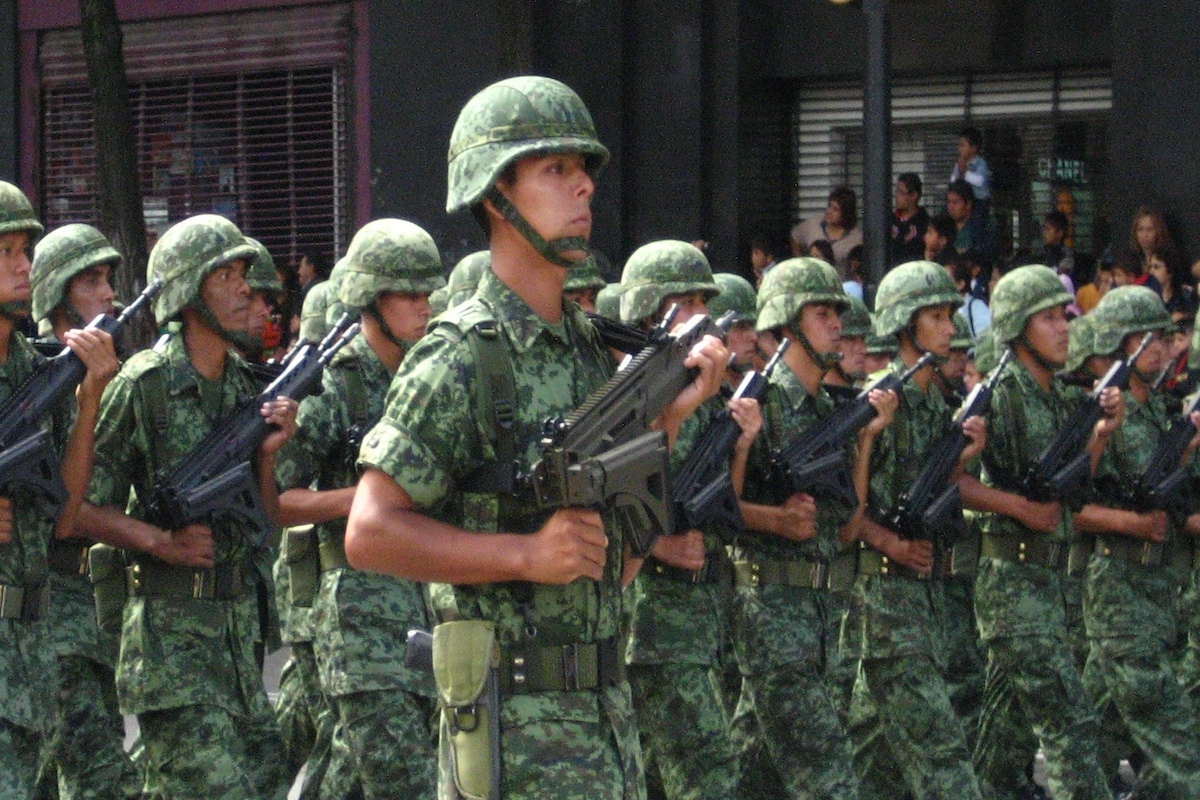

Mexican soldiers on parade in Mexico’s independence day parade in 2009, Mexico DF. (Photo by eeliuth/CC-BY)
By José Manuel Aburto, University of Southern Denmark and Froylan Enciso, Centro de Investigación y Docencia Económicas
Most countries in the world have experienced sizable improvements in health, living standards and life expectancy since the second half of the 20th century. In Mexico, life expectancy increased for more than six decades, but as we found in our new research, this rate slowed down between 2005 and 2015, and in some states even reversed.
This slow-down coincides with an unprecedented rise in violence. The number of homicides for men increased by more than 50% between 2005 and 2015, from 20.4 to 31.2 per 100,000 men. There were 262,459 registered murders in that period. As a result, gains in life expectancy for young men due to reductions in other causes of death, such as infectious and respiratory diseases, floundered.
Life expectancy is generally used to monitor population health. But this indicator doesn’t tell the whole story, as it masks substantial variation in length of life. Inequality in length of life is the most fundamental of all inequalities: after all, every other type of inequality depends on being alive.
Greater uncertainty about life expectancy obviously impacts negatively on quality of life. Since 2005, this question has become more difficult to answer for Mexican males, such as ourselves, and current conditions do not suggest that this will get better. From a public health perspective, a larger lifespan inequality implies a vulnerable society.
At the state level, the strongest effect occurred in Guerrero, a state in the south of the country, where 43 students disappeared in 2014. Here, life expectancy was reduced by two years over the period and lifespan inequality increased substantially.
Chihuahua and Sinaloa, in the north, also experienced reversed life expectancy trends, with losses of one year each. To put these figures in perspective, in 2010, men aged 15 to 50 years in Chihuahua (which borders the US state of Texas) had a mortality rate that was three times higher than the US troops in Iraq between 2003 and 2006.
The War on Drugs
The sudden increase of violence in Mexico is associated with military interventions to decrease illicit drug operations and organized crime since 2006, when president Felipe Calderón launched a “war” against drugs and criminals. This, along with the so-called kingpin strategy of apprehending or killing the most prominent leaders in organized crime, increased competition and violence within criminal organizations. The persistent dispute led to the fragmentation of criminal organizations, which fed the violent cycle.
At the same time, drug trade flows changed with a boom in the contraband of opiates and opioids to make up for a reduction in the price of cocaine and the decrease of marijuana exports due to its legalization in parts of the U.S. But criminals also engaged in other illicit activities, such as protection rackets, migrant kidnappings, oil theft, extortion, and the illegal trade of weapons and persons. The so-called war on drugs has become an unfinished violent cycle that has decimated the country’s social fabric.
Mexico has also systematically failed to recognize and correct the detrimental consequences for health and human rights that drug prohibition policies have had on the population.
Now, the new government of Andrés Manuel López Obrador has promised to take care of the deep causes of violence. New social programs focused on creating job and education opportunities for the young and other vulnerable groups are at the heart of his strategy. Nevertheless, he insists on asking Congress to reform the Constitution to legalize the use of the armed forces for public security and investigative tasks against crime. And this despite the fact that it was their intervention that contributed to the violent competition among organized criminals in the first place.
The Mexican government’s new focus on improving social and human capital through education, community support and employment programs should of course be celebrated. Whereas the state used to see drugs mainly as a national security problem, it has begun to recognize its violent consequences as a social justice challenge.
But there is no conclusive evidence to suggest that inequality is the main cause of violent behaviour, even though it is a great factor of vulnerability. So this new approach may be shortsighted. Meanwhile, the evidence that punitive and prohibitionist drug policies have helped trigger the current violence, as well as economic, human rights and health crises piles up.
The Mexican government’s new policy of combating poverty and inequality is well-intended, but drug policy reform really needs to be the top priority. The new president has promised to end to the “war” on drugs. Substantiating this promise by regulating marijuana and poppy is a step towards ending the cycle of violence.![]()
![]()
This article is republished from The Conversation under a Creative Commons license. Read the original article.


